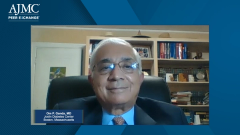
Economic Burden of Cardiorenal Metabolic Syndrome
A panel of experts led by Neil Minkoff, MD, discuss health care resource utilization and economic burden associated with cardiorenal metabolic syndrome.
Episodes in this series

Neil Minkoff, MD: Having been a primary care doctor and looking at this from both a hospital network point of view and from a payer lens, these tend to be complicated patients who have a tremendous amount of resource utilization. It’s difficult to say that health care research utilization should be at an average level for patients who have some combination of renal dysfunction, CHF [congestive heart failure], and metabolic dysfunction and diabetes, but they shouldn’t be uncontrolled either. The things that we would be looking at would be ED [emergency department] and hospitalization rates. I’m not sure if dialysis rates are an appropriate measure of this or if they are just another way of managing the most complex patients. I don’t know if that’s a fair outcome to be looking at. One of the other truths is that combining these things dramatically increases the risk of inappropriate hospitalizations. That doesn’t mean that the patient did not need to be hospitalized at that moment. It means it was more preventable, either with more longitudinal care or more aggressive care in the outpatient sphere. I’m not convinced. I don’t believe that we’ve done a great job on the payer side of transitioning from disease state management or control—looking at a condition, to even metabolic syndrome, which is more of the cardiorenal metabolic syndrome. There’s work to be done to remove some of those barriers. When you guys are in your clinics, do you measure hospitalization rate? When you do so, is it in aggregate, or are you just looking at hospitalizations as an outcome on a per patient level?
Jeffrey Turner, MD: I am more looking at it on the per-patient level within my individual clinic. My experience is probably true for a lot of providers here, at Yale, and elsewhere. There are developing tools within our health care system and our electronic health medical record to help look at things more broadly, across a provider and various clinics, to get ideas of hospitalization rates across the entire patient population. That’s not something that has been engrained in the culture at the individual provider level. I’m mainly looking at that individual patient and will wait for more of those larger tools to come online and be readily accessible.
Nihar R. Desai, MD, MPH: My experience largely parallels Jeff’s. If you talk to a patient, their family, and their caregivers, that’s an outcome that really matters to them. Avoiding hospitalization and having days away from their loved ones or their life is challenging. It matters to patients. There’s a push in our health system to have us look at data and analytics for our populations or the patients that we care for. In some of the administrative work that I do for our bundle population, or for our ACO [accountable care organizations] or other at-risk populations, we are bearing financial risk and are driving value. We’re looking at those important metrics around resource utilization, quality metrics and outcomes, performance, and patient satisfaction. Is the health care system delivering for our patients in our community? From that standpoint, hospitalization is one element of a multifaceted assessment that we would want to do.
Om P. Ganda, MD: In complicated patients with diabetes, we see most of them in the hospital requiring insulin treatment, even if there are oral drugs before. That alone makes the care even more complicated at the time of discharge—how to advise the family, how to educate the patient, how quickly to get them to come back to see us in the office. I am working in a clinic where we have the luxury of diabetes educators and nurse practitioners, where we have a transition clinic. We recently did a small study where we looked at the rates of ED visits in patients who are properly advised versus a group that was not advised. It has yet to be published, but we found that we were able to reduce the rate of ED visits after the transition clinic was instituted. Small efforts like that will pay off in the long run. We know that patients who come into the hospital these days are highly complicated because we do much more care as an outpatient versus when they’re brought to the hospital.
Transcript edited for clarity.
Newsletter
Stay ahead of policy, cost, and value—subscribe to AJMC for expert insights at the intersection of clinical care and health economics.








